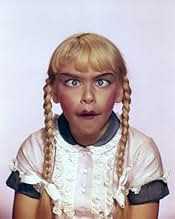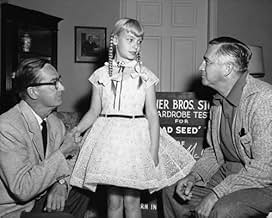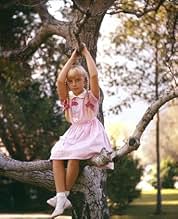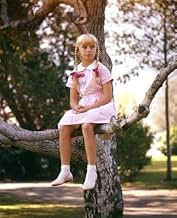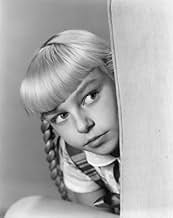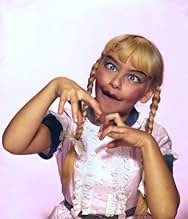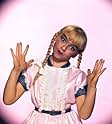NOTE IMDb
7,4/10
17 k
MA NOTE
Ajouter une intrigue dans votre langueRhoda Penmark seems like your average, sweet eight-year-old girl. After her rival at school dies in mysterious circumstances at the school picnic, her mother starts to suspect that Rhoda was... Tout lireRhoda Penmark seems like your average, sweet eight-year-old girl. After her rival at school dies in mysterious circumstances at the school picnic, her mother starts to suspect that Rhoda was responsible.Rhoda Penmark seems like your average, sweet eight-year-old girl. After her rival at school dies in mysterious circumstances at the school picnic, her mother starts to suspect that Rhoda was responsible.
- Réalisation
- Scénario
- Casting principal
- Nommé pour 4 Oscars
- 1 victoire et 6 nominations au total
Joan Croydon
- Miss Fern
- (as Joan Croyden)
Frances Bavier
- Woman in Dinner Party
- (non crédité)
Violet N. Cane
- Teacher
- (non crédité)
Vivian Clermont
- Mary Beth Musgrove
- (non crédité)
Shelley Fabares
- Margie
- (non crédité)
Kathy Garver
- Rhoda's Classmate
- (non crédité)
Don C. Harvey
- Guard in Hospital Corridor
- (non crédité)
Edna Holland
- Saleslady
- (non crédité)
Avis à la une
Minor 1950's classic that holds up well fifty year later. The film does have its flaws. Occasionally it has the feel of a staged play--at times it seems Mrs. Penmark has to answer the door every five minutes so as to get the other major characters on screen. The Freudian psychobabble and the altered ending add an unnecessary half hour or so to the running time. And the acting can be very overwrought (although the scene in which Mrs. Penmark is screaming in the apartment as Leroy screams outside--both counterpointed by Rhoda's untalented but very loud rendition of "Au Clair de la Lune"--is a moment of high camp horror on par with anything in "Whatever Happened to Baby Jane?") Still the movie works, largely because of Rhoda, the eerily self controlled little murderess who despite her sweet smiles always looks at though her hair is braided a bit too tight. It helps that an actress was cast who was cute enough, but not too pretty--Patty McCormack looks like a miniature gargoyle when she drops the sunny mask and starts roaring. Leroy, the leering simple minded caretaker is almost as unsettling--the scenes in which he sadistically taunts Rhoda almost amount to a very twisted flirtation, as he is clearly more delighted than appalled by her capacity for evil (at least until he learns just how far this capacity goes).
I haven't seen the 1980's remake, but I can't see how it could top the original, if only because evil little girls in jeans and T-shirts just aren't as scary as evil little girls with hair bows and starched frocks.
I haven't seen the 1980's remake, but I can't see how it could top the original, if only because evil little girls in jeans and T-shirts just aren't as scary as evil little girls with hair bows and starched frocks.
I was blown away! I was at the edge of my seat the whole time. Those people gave me the creeps. I was just flipping through the channels when I came across it. Normally I'll change the channel after a minute or two to see what else is on, but not when I saw this movie! I was so terrified, I sat through the whole movie, uninterrupted. I'm shivering just thinking about it right now!
I love this movie. I have read many reviews from professionals and they all seem to think the movie is too theatrical and you can tell it was a stage play and that the mother is especially dramatic. She is, that's true, but in the same way Faye Dunaway chews up Mommie Dearest and we all know what a hoot that is. Little Rhoda is a real stinker. The handyman had better "give her those shoes." The subplot of the mother's own identity is fun too. All in all, the movie is very 50s. You can almost see Wally and the Beaver coming down the street. Great! There is also some discussion about the formal introduction of the cast at the end which I've always found a very nice touch. Much older films of the 30s used to do that all the time. It's been said this film did it to show the characters were just flesh and blood actors and so their roles and the subject matter (especially Patty McCormack) shouldn't be taken seriously. See it. By the way, there is one review on this site by someone who says they saw the movie at age 12 that is very negative. Don't believe it!
I saw "The Bad Seed" years ago, circa 1970, for the first time, and have seen it periodically over the years. When I first saw the film, as a child, I found the film, expectedly, quite chilling.
I saw it again this afternoon, after not having seen it for about three years, and still find it quite disturbing. Now that we have IMDb, I decided to offer my thoughts. And so, I was shocked to find SO MANY comments about it...more than for any other film that I've reviewed on IMDb to date. If I add anything of unique value, great. If not, I'm happy to share my review anyway.
Certainly, there are flaws, or perhaps only "unique differences", in this film. Primarily, it can very easily be considered a filmed play, as the staging, the dialog, and the entrances and exits of the characters throughout the film seem to be lifted directly from the stage version. Therefore, some may find the film a bit too sterile or unnatural in many ways. However, I think it is this very sterile, staged, stark-from-a-production-standpoint quality that gives the film an even eerier and in some ways far more realistic edge than might be found were it to be produced today for film, with far more slick and sophisticated sets, dialog, camera work, etc. The realism and pronounced disturbing quality of this version stems from the simple story itself, the psychological horror of which could be in some ways obfuscated from a much more sophisticated, big-studio, modern-day production.
As for the subject matter itself, I know that the number of cases, historically, involving child murderers is actually low. Therefore, some critics have argued that to take a relatively rare phenomenon, such as the child murderer, and build a motion picture around it, portraying it in the vein of plausibility, can be misleading and dangerous, giving the impression, especially to younger viewers, that child criminals are more commonplace than you may think. I wholeheartedly reject this notion. The whole purpose of acting is to portray the entire range of the human condition with as much truth as possible, no matter how rare or commonplace certain aspects of human behavior might be. Though child murderers may be few in number, it's an area worthy of as much exploration, in film, as is an ugly, unrealistic alien telling us to "phone home" or the sinking of the Titanic.
Even though this film possesses a definite "campy", staged, and perhaps even "cult" quality, it is chillingly effective. One reason for which this film works is due to the character of Rhoda herself, played by Patty McCormack. The smiling, blond, blue-eyed veneer of the child juxtaposed with the idea of her criminal potential (and actions) is just plain "creepy". Moreover, the less you see, in terms of the actual crimes she commits, the more you conjure. And, you continually wonder who her next victim will be. Furthermore, you wonder how many people will eventually "come on to her" and become aware of whom she is, and how that knowledge will affect their fate.
Another reason for which this film works is because of the mother, Christine, played by Nancy Kelly. As we slowly watch her become aware of what has become of her daughter, we can't help but empathize with her predicament and her decision in handling it. The first few times I saw the film, just as I felt that Patty McCormack's portrayal and dialog delivery were probably mere replicas of what she offered on stage, I felt that Nancy Kelly's performance was affected and probably lifted directly from her work on the stage (I've never seen a stage version, nor have I read the book, yet). But in the case of Ms. Kelly, watching her realize what she has ultimately given birth to and raised is very heart wrenching. Moreover, I have always wondered if the use of her right hand was a direction given to her by either of her directors (for play or film), or if it was something she came up with herself. Two instances come to mind.
In the first one, the manner in which she hits the table with her right hand as she listens to what is happening outside near her shed while Rhoda plays "Au Claire de la Lune" on her piano is very pronounced, appears somewhat odd and is perhaps symbolic. She seemed to be pounding her hand not only in outward denial and anger at the realization she now has of what her child is capable of committing, but as a means to torture and punish herself for having given birth to her in the first place. In the second instance, Nancy Kelly used her right hand again in a very pronounced manner when she offers Rhoda her vitamins "that night". Again, I couldn't help but wonder what symbolism she wanted us to draw from her gesture. It might be said that this very hand, which once comforted and fed her child all her life, has now become the tool that feeds the ultimate fate of her child toward the end of the film. (Again, not having read it, I have a fairly good idea how the book ends).
As for how the ending/epilogue in the film was handled, practically everyone on this site who has offered a review knows that the use of the "casting call" was basically dictated by the mandates of the Hays Code. I'll just add that I find that the chilling effect of the story carries over to this bizarre "epilogue". I still find it a bit unsettling to see each of these actors take their bows, especially considering that some of the characters they portrayed would, in my estimation, appear stranger to a child than does Rhoda....particularly Leroy, when he bows to the viewing audience carrying his large pitchfork.
I saw it again this afternoon, after not having seen it for about three years, and still find it quite disturbing. Now that we have IMDb, I decided to offer my thoughts. And so, I was shocked to find SO MANY comments about it...more than for any other film that I've reviewed on IMDb to date. If I add anything of unique value, great. If not, I'm happy to share my review anyway.
Certainly, there are flaws, or perhaps only "unique differences", in this film. Primarily, it can very easily be considered a filmed play, as the staging, the dialog, and the entrances and exits of the characters throughout the film seem to be lifted directly from the stage version. Therefore, some may find the film a bit too sterile or unnatural in many ways. However, I think it is this very sterile, staged, stark-from-a-production-standpoint quality that gives the film an even eerier and in some ways far more realistic edge than might be found were it to be produced today for film, with far more slick and sophisticated sets, dialog, camera work, etc. The realism and pronounced disturbing quality of this version stems from the simple story itself, the psychological horror of which could be in some ways obfuscated from a much more sophisticated, big-studio, modern-day production.
As for the subject matter itself, I know that the number of cases, historically, involving child murderers is actually low. Therefore, some critics have argued that to take a relatively rare phenomenon, such as the child murderer, and build a motion picture around it, portraying it in the vein of plausibility, can be misleading and dangerous, giving the impression, especially to younger viewers, that child criminals are more commonplace than you may think. I wholeheartedly reject this notion. The whole purpose of acting is to portray the entire range of the human condition with as much truth as possible, no matter how rare or commonplace certain aspects of human behavior might be. Though child murderers may be few in number, it's an area worthy of as much exploration, in film, as is an ugly, unrealistic alien telling us to "phone home" or the sinking of the Titanic.
Even though this film possesses a definite "campy", staged, and perhaps even "cult" quality, it is chillingly effective. One reason for which this film works is due to the character of Rhoda herself, played by Patty McCormack. The smiling, blond, blue-eyed veneer of the child juxtaposed with the idea of her criminal potential (and actions) is just plain "creepy". Moreover, the less you see, in terms of the actual crimes she commits, the more you conjure. And, you continually wonder who her next victim will be. Furthermore, you wonder how many people will eventually "come on to her" and become aware of whom she is, and how that knowledge will affect their fate.
Another reason for which this film works is because of the mother, Christine, played by Nancy Kelly. As we slowly watch her become aware of what has become of her daughter, we can't help but empathize with her predicament and her decision in handling it. The first few times I saw the film, just as I felt that Patty McCormack's portrayal and dialog delivery were probably mere replicas of what she offered on stage, I felt that Nancy Kelly's performance was affected and probably lifted directly from her work on the stage (I've never seen a stage version, nor have I read the book, yet). But in the case of Ms. Kelly, watching her realize what she has ultimately given birth to and raised is very heart wrenching. Moreover, I have always wondered if the use of her right hand was a direction given to her by either of her directors (for play or film), or if it was something she came up with herself. Two instances come to mind.
In the first one, the manner in which she hits the table with her right hand as she listens to what is happening outside near her shed while Rhoda plays "Au Claire de la Lune" on her piano is very pronounced, appears somewhat odd and is perhaps symbolic. She seemed to be pounding her hand not only in outward denial and anger at the realization she now has of what her child is capable of committing, but as a means to torture and punish herself for having given birth to her in the first place. In the second instance, Nancy Kelly used her right hand again in a very pronounced manner when she offers Rhoda her vitamins "that night". Again, I couldn't help but wonder what symbolism she wanted us to draw from her gesture. It might be said that this very hand, which once comforted and fed her child all her life, has now become the tool that feeds the ultimate fate of her child toward the end of the film. (Again, not having read it, I have a fairly good idea how the book ends).
As for how the ending/epilogue in the film was handled, practically everyone on this site who has offered a review knows that the use of the "casting call" was basically dictated by the mandates of the Hays Code. I'll just add that I find that the chilling effect of the story carries over to this bizarre "epilogue". I still find it a bit unsettling to see each of these actors take their bows, especially considering that some of the characters they portrayed would, in my estimation, appear stranger to a child than does Rhoda....particularly Leroy, when he bows to the viewing audience carrying his large pitchfork.
With some familiar elements of classic thrillers plus some creative turns, this is an unusual and effective thriller. Patty McCormack is memorable as young Rhoda, and the rest of the cast succeed in making their characters react believably to some nearly unbelievable situations. The story moves slowly enough to build suspense carefully, while still holding your interest the whole time.
For this kind of story to work, it has to keep the tension and uncertainty without becoming obviously implausible or annoyingly overplayed. In "The Bad Seed", we see the tension and fear that build in the characters as the story develops, but events also unfold within an atmosphere that otherwise would be peaceful and normal, making for an interesting contrast that helps to maintain a good balance.
Unlike the many banal movies made in recent years about serial killers and the like, "The Bad Seed" also contains some substance. The characters, especially the mother (played by Nancy Kelly), not only have to make difficult decisions, but also must fearfully attempt to understand the reasons for everything. It's a good example of how well a thriller can work when carefully made without a lot of extraneous elements, and it's a demonstration that a movie can have a tense, dark story without being shallow or superficial at the same time.
For this kind of story to work, it has to keep the tension and uncertainty without becoming obviously implausible or annoyingly overplayed. In "The Bad Seed", we see the tension and fear that build in the characters as the story develops, but events also unfold within an atmosphere that otherwise would be peaceful and normal, making for an interesting contrast that helps to maintain a good balance.
Unlike the many banal movies made in recent years about serial killers and the like, "The Bad Seed" also contains some substance. The characters, especially the mother (played by Nancy Kelly), not only have to make difficult decisions, but also must fearfully attempt to understand the reasons for everything. It's a good example of how well a thriller can work when carefully made without a lot of extraneous elements, and it's a demonstration that a movie can have a tense, dark story without being shallow or superficial at the same time.
Le saviez-vous
- AnecdotesThe original Broadway production of "The Bad Seed" by Maxwell Anderson opened on December 8, 1954 and ran for 334 performances. Nancy Kelly won the 1955 Tony Award for Actress in a Drama and recreated her part in the movie. Patty McCormack, Eileen Heckart, Evelyn Varden, Henry Jones and Joan Croydon also recreated their stage roles in the movie version.
- GaffesWhen Christine scolds Rhoda for asking for a garnet as well as a turquoise, the reflection of someone, probably Mervyn LeRoy, sitting in a chair with his legs crossed is visible in the coffee pot. Addition: Just to the left of the reflection that is assumed to be LeRoy you can see other crew members moving in the shadow of the door frame reflected in the coffee pot.
- Crédits fousAfter the finale, a narrator tells the audience "One moment please. And now our wonderful cast." Then, the principal cast members are introduced one by one, like they would be at the end of a play. After that's done with, there's a brief scene in which Nancy Kelly spanks Patty McCormack.
- ConnexionsFeatured in L'amie mortelle (1986)
- Bandes originalesAu clair de la lune
(uncredited)
Attributed to Jean-Baptiste Lully
Played on the piano by Patty McCormack and whistled by Henry Jones
Played often in the score
Meilleurs choix
Connectez-vous pour évaluer et suivre la liste de favoris afin de recevoir des recommandations personnalisées
Détails
- Date de sortie
- Pays d’origine
- Langue
- Aussi connu sous le nom de
- La mala semilla
- Lieux de tournage
- Midwest Street, Warner Brothers Burbank Studios - 4000 Warner Boulevard, Burbank, Californie, États-Unis(as Tidewater Arms Apartments exteriors)
- Société de production
- Voir plus de crédits d'entreprise sur IMDbPro
Box-office
- Budget
- 1 000 000 $US (estimé)
- Durée2 heures 9 minutes
- Couleur
- Rapport de forme
- 1.85 : 1
Contribuer à cette page
Suggérer une modification ou ajouter du contenu manquant

Lacune principale
By what name was La Mauvaise Graine (1956) officially released in India in English?
Répondre

